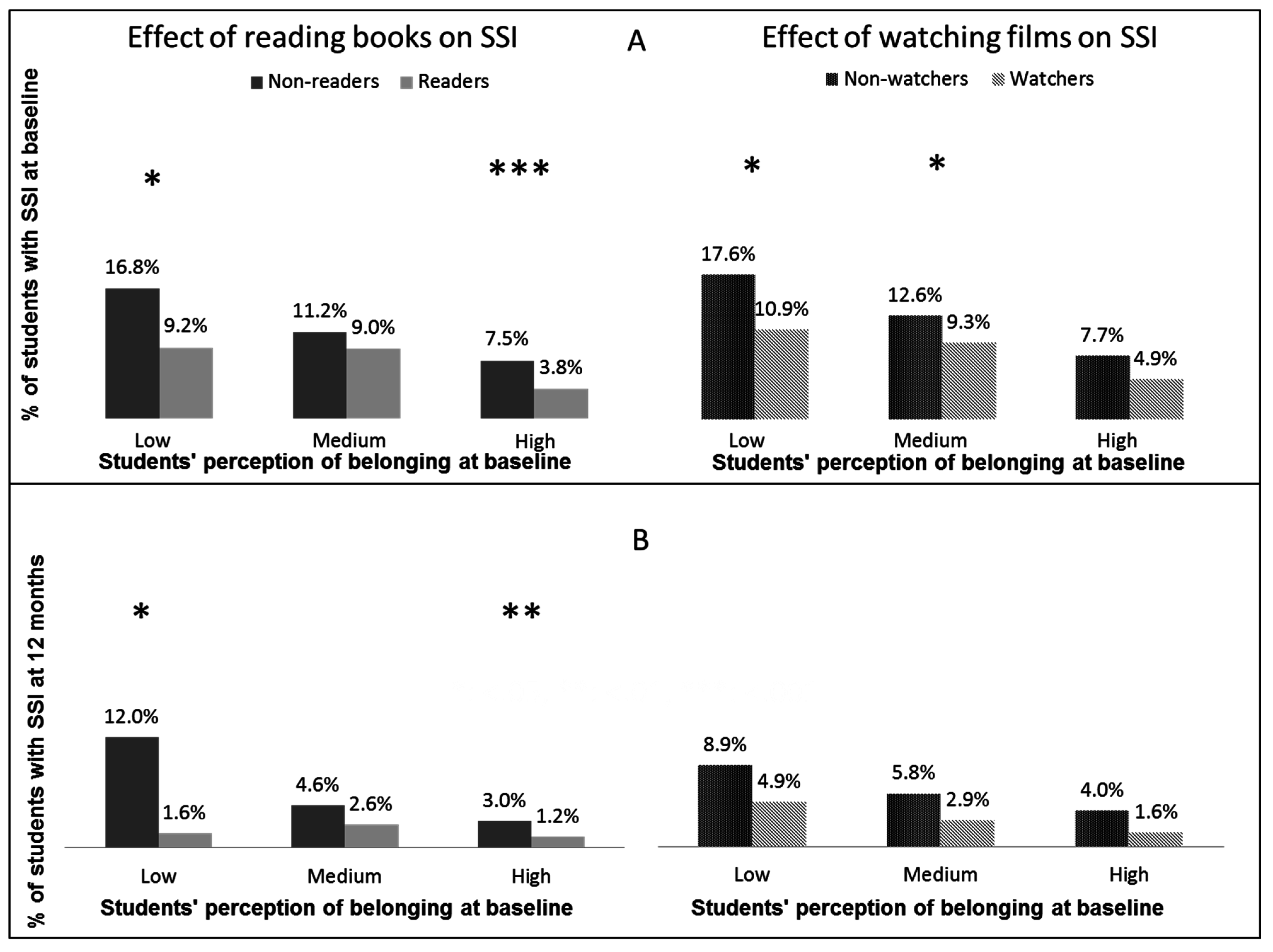Reading Books and Watching Films as a Protective Factor against Suicidal Ideation
Abstract
:1. Introduction
2. Experimental Section
3. Results and Discussion
3.1. Results
| Studied Variables | SSI at Baseline | p-Value | |
|---|---|---|---|
| – | SSI − | SSI + | – |
| n (%) | 2980 (92.7) | 233 (7.2) | – |
| Age mean ± SD | 14.87 ± 0.92 | 14.95 ± 0.968 | 0.24 |
| Gender male (%) | 1429 (93.8) | 95 (6.2) | 0.02 |
| Female (%) | 1539 (73.9) | 137 (8.2) | – |
| Number of books mean ± SD | 1.83 ± 1.27 | 1.50 ± 1.28 | 0.00 |
| Number of films mean ± SD | 2.47 ± 0.99 | 2.22 ± 1.14 | 0.00 |
| Belonging Low (%) | 261 (8.9) | 37 (16.5) | 0.00 |
| Middle (%) | 730 (25.0) | 80 (35.7) | – |
| High (%) | 1933 (66.1) | 107 (47.8) | – |
| Worthlessness High (%) | 12 (0.4) | 18 (7.8) | 0.00 |
| Low (%) | 2537 (85.7) | 102 (44.2) | – |
| Belonging and worthlessness: % within SSI +/− | – | – | |

3.2. Discussion
4. Conclusions
Acknowledgments
Author Contributions
Conflicts of Interest
References
- Westerlund, M.; Hadlaczky, G.; Wasserman, D. The representation of suicide on the internet: Implications for clinicians. J. Med. Internet. Res. 2012, 14. [Google Scholar] [CrossRef] [PubMed]
- Sisask, M.; Värnik, A. Media roles in suicide prevention: A systematic review. Int. J. Environ. Res. Public Health 2012, 9, 123–138. [Google Scholar] [CrossRef] [PubMed]
- Niederkrotenthaler, T.; Voracek, M.; Herberth, A.; Till, B.; Strauss, M.; Etzersdorfer, E.; Eisenwort, B.; Sonneck, G. Role of media reports in completed and prevented suicide: Werther v. Papageno effects. Br. J. Psychiatry 2010, 197, 234–243. [Google Scholar] [CrossRef] [PubMed]
- Hatcher, S.; Stubbersfield, O. Sense of belonging and suicide: A systematic review. Can. J. Psychiatry 2013, 58, 432–436. [Google Scholar] [PubMed]
- Guthrie, J.T.; Schafer, W.D.; Hutchinson, S.R. Relations of document literacy and prose literacy to occupational and societal characteristics of young black and white adults. Read. Res. Q. 1991, 26, 30–48. [Google Scholar] [CrossRef]
- Bandura, A. Social cognitive theory for personal and social change by enabling media. In Entertainment-Education and Social Change: History, Research, and Practice; Singhal, A., Cody, J.M., Rogers, M.E., Sabido, M., Eds.; Routledge: London, UK, 2004; pp. 75–96. [Google Scholar]
- Wasserman, D.; Hoven, C.W.; Wasserman, C.; Wall, M.; Eisenberg, R.; Hadlaczky, G.; Kelleher, I.; Sarchiapone, M.; Apter, A.; Balazs, J.; et al. School-based suicide prevention programmes: The seyle cluster-randomised, controlled trial. The Lancet 2015, 385, 1536–1544. [Google Scholar] [CrossRef]
- Paykel, E.S.; Myers, J.K.; Lindenthal, J.J.; Tanner, J. Suicidal feelings in the general population: A prevalence study. Br. J. Psychiatry 1974, 124, 460–469. [Google Scholar] [CrossRef] [PubMed]
- Fisher, L.B.; Overholser, J.C.; Ridley, J.; Braden, A.; Rosoff, C. From the outside looking in: Sense of belonging, depression, and suicide risk. Psychiatry 2015, 78, 29–41. [Google Scholar] [PubMed]
- Browne, K.D.; Hamilton-Giachritsis, C. The influence of violent media on children and adolescents: A public-health approach. Lancet 2005, 365, 702–710. [Google Scholar] [CrossRef]
- Saewyc, E.W.N.; Chittenden, M.; Murphy, A. Building Resilience in Vulnerable Youth; McCreary Centre Society: Vancouver, BC, Canada, 2006. [Google Scholar]
- Matlin, S.L.; Molock, S.D.; Tebes, J.K. Suicidality and depression among African American adolescents: The role of family and peer support and community connectedness. Am. J. Orthopsychiatry 2011, 81, 108–117. [Google Scholar] [CrossRef] [PubMed]
- Everall, R.D.; Altrows, K.J.; Paulson, B.L. Creating a future: A study of resilience in suicidal female adolescents. J. Couns. Dev. 2006, 84, 461–470. [Google Scholar] [CrossRef]
- McHale, S.M.; Blocklin, M.K.; Walter, K.N.; Davis, K.D.; Almeida, D.M.; Klein, L.C. The role of daily activities in youths’ stress physiology. J. Adolesc. Health 2012, 51, 623–628. [Google Scholar] [CrossRef] [PubMed]
- Bifulco, A.; Schimmenti, A.; Moran, P.; Jacobs, C.; Bunn, A.; Rusu, A.C. Problem parental care and teenage deliberate self-harm in young community adults. Bull. Menninger Clin. 2014, 78, 95–114. [Google Scholar] [CrossRef] [PubMed]
© 2015 by the authors; licensee MDPI, Basel, Switzerland. This article is an open access article distributed under the terms and conditions of the Creative Commons by Attribution (CC-BY) license (http://creativecommons.org/licenses/by/4.0/).
Share and Cite
Kasahara-Kiritani, M.; Hadlaczky, G.; Westerlund, M.; Carli, V.; Wasserman, C.; Apter, A.; Balazs, J.; Bobes, J.; Brunner, R.; McMahon, E.M.; et al. Reading Books and Watching Films as a Protective Factor against Suicidal Ideation. Int. J. Environ. Res. Public Health 2015, 12, 15937-15942. https://doi.org/10.3390/ijerph121215032
Kasahara-Kiritani M, Hadlaczky G, Westerlund M, Carli V, Wasserman C, Apter A, Balazs J, Bobes J, Brunner R, McMahon EM, et al. Reading Books and Watching Films as a Protective Factor against Suicidal Ideation. International Journal of Environmental Research and Public Health. 2015; 12(12):15937-15942. https://doi.org/10.3390/ijerph121215032
Chicago/Turabian StyleKasahara-Kiritani, Mami, Gergö Hadlaczky, Michael Westerlund, Vladimir Carli, Camilla Wasserman, Alan Apter, Judit Balazs, Julio Bobes, Romuald Brunner, Elaine M. McMahon, and et al. 2015. "Reading Books and Watching Films as a Protective Factor against Suicidal Ideation" International Journal of Environmental Research and Public Health 12, no. 12: 15937-15942. https://doi.org/10.3390/ijerph121215032






